IoT WiFi Microcontroller Development Boards
Updated: 16Aug2024 03:12:14 UTC 2024-08-16T03:12:14Z
Rating: (0 reviewsThis article has not been rated yet)
A WiFi microcontroller development board is a complete hardware platform that provides convenient I/OInput/Output interfaces to a microcontroller chip and the capability of wireless communication over a WiFi network.
The components of a WiFi microcontroller dev board consists of a processor chip (MCUMicrocontroller Unit or SoCSystem On a Chip), external flash memory chip, oscillator, PCBPrinted Circuit Board antenna or uFL connector for an external antenna, USBUniversal Serial Bus interface, voltage regulator, power and logic 5V to 3.3V voltage level converters, reset and boot buttons, LEDLight Emitting Diodes, and I/O pins.
Some WiFi development boards have the processor chip, external flash memory chip, oscillator, and antenna all contained in a module that is mounted on the development board.
This overview covers common WiFi Microcontroller Development Boards for IoTInternet Of Things Applications, such as the ESP8266, ESP32, ESP32-C, ESP32-S, CYW43439 in the RPiRaspberry Pi Pico W, ATWINC1500 in Adafruit's Feather M0, and the DA16200 in SparkFun's Thing Plus.
ESP8266
The defining feature of ESP8266 development boards is the ESP8266EX SoCSystem On a Chip chip by Espressif. The ESP8266EX SoC integrates a Tensilica based L106 single core 32-bit MCUMicrocontroller Unit that runs at 80MHz (default) or 160MHz, antenna transmit-receive switches, RF balun, power amplifier, LNALow Noise Amplifier, filters, and power management.
The ESP8266EX SoC supports 2.4GHz 802.11IEEE 802.11 is a set of protocol standards that define communication for a Wireless Local Area Network (WLAN). In order for WiFi to work between different devices, they all need to agree on how they are going to communicate. The current version of the standard is IEEE 802.11-2007, with many amendments such as 802.11a, 802.11b, 802.11g, and 802.11n.b/g/n WiFi up to 72.2Mbps, three WiFi modes (APA WiFi Access Point (AP) is a device that creates a wireless local area network, or WLAN, and acts as a central hub that allows other devices, such as smartphones or computers, to connect to it over WiFi., STAA WiFi Station (STA) is a device that has the capability to connect to an existing WiFi network as a client in the same way other devices, such as smartphones or computers, join an established network and communicate with other devices on that network or access the internet., AP+STAA WiFi device in AP+STA mode acts as both an Access Point (AP) as well as a Station (STA), where the device can connect to an existing network as a client (STA) while simultaneously hosting its own network (AP) for other devices to connect to.), with UARTUniversal Asynchronous Receiver-Transmitter/I2CInter-Integrated Circuit. Also referred to as IIC or I2C./SPISerial Peripheral Interface/SDIOSecure Digital Input Output (SDIO) is a communication interface that allows devices to connect to an SD card and exchange data./I2SInter-IC Sound communication interfaces, and GPIOGeneral Purpose Input Output/PWMPulse-Width Modulation/ADCAnalog-to-Digital Converter (ADC, A/D, or A-to-D) peripheral interfaces. There is no programmable ROMRead-Only Memory in the ESP8266EX SoC, so the user program must be stored in an external SPI flash chip. More details on the ESP8266EX chip can be found in the ESP8266EX Datasheet (PDF).
ESP8266 NodeMCU
The ESP8266 NodMCU development boards contain the following components:
- ESP8266 ESP-12E/F WiFi module with an ESP8266EX SoCSystem On a Chip, 4MB flash memory chip, and PCBPrinted Circuit Board antenna
- Micro or Type-C USB connector for power and data transfer
- CP2102 or CH340 USB-to-UART converter chip
- 3.3V LDOLow Dropout Regulator voltage regulator
- 2x buttons for Reset and Flash
- 2x Blue LEDLight Emitting Diodes connected to GPIO2 and GPIO16
- 30x pins (15 on each side of the board) with 0.1" (2.54mm) spacing
The I/OInput/Output pins on the NodeMCU are 3.3V (max) and include:
- 17x GPIOGeneral Purpose Input Output with PWMPulse-Width Modulation
- 1x analog input (10-bit ADCAnalog-to-Digital Converter (ADC, A/D, or A-to-D))
- 2x UARTUniversal Asynchronous Receiver-Transmitter
- 2x SPISerial Peripheral Interface
- 1x SDIOSecure Digital Input Output (SDIO) is a communication interface that allows devices to connect to an SD card and exchange data.
- Software implementation of I2CInter-Integrated Circuit. Also referred to as IIC or I2C. on all GPIO pins
- I2SInter-IC Sound interfaces with DMADirect Memory Access (sharing pins with GPIO)
The ESP8266 NodMCU can come with either a ESP-12E or ESP-12F module. The ESP-12F has an improved circuit and antenna design for better radio performance over the ESP-12E, but they are both the same size and fully compatible.
ESP8266 D1 Mini
WEMOS is a Chinese company that designs IoTInternet Of Things products with their official store front on AliExpress. One of their most popular development boards is the ESP8266 Wemos D1 Mini, where documentation on this board can be found at wemos.cc. The Wemos D1 Mini V4.0.0 board has a small form factor of 34.2mm x 25.6mm (1.35in x 1.01in) and contains the following components:
- ESP8266EX SoC with 4MB flash memory chip, 40MHz Crystal Oscillator, and PCB antenna
- 4-Pin JST-SH I2C connector
- USB Type-C connector for power and data transfer
- CH340 USB-to-UART converter chip
- 3.3V LDOLow Dropout Regulator voltage regulator
- Reset button on the side of the board
- 1x blue LEDLight Emitting Diode connected to GPIO2
- 16x pin through holes (8 on each side of the board) with 0.1" (2.54mm) spacing
The I/O pins on the D1 Mini are 3.3V (max) and include:
- 11x GPIO with PWM
- 1x analog input (10-bit ADC, 3.2V max input)
- 1x UART, 1x I2C, and 1x SPI
There is also a 4-Pin JST-SH connector for I2C on the top of the board. However, the VCCVoltage Collector Collector (VCC) is the supply voltage at the collector of a transistor. The double subscript notation of repeating letters "CC" is used to denote a power supply voltage that is relative to ground. and GNDCommon Ground pins on this connector are not compatible with the SparkFun's QwiicQwiic connectors are SparkFun's name for 4-pin JST SH connectors with 1.0mm pitch. These connectors were implemented on SparkFun boards to make it easy to plug-n-play various sensors and devices without soldering and wiring. Qwiic is cross-compatible with Adafruit's STEMMA QT connectors. and Adafruit's STEMMA QTSTEMMA QT ('cutie') connectors are Adafruit's name for 4-pin JST SH connectors with 1.0mm pitch. These connectors were implemented on Adafruit boards to make it easy to plug-n-play various sensors and devices without soldering and wiring. The STEMMA QT (JST SH) are a smaller connector than the STEMMA (JST PH) that do not fit on smaller boards. STEMMA QT is cross-compatible with SparkFun Qwiic connectors. connectors: instead of Qwiic/STEMMA QT pinout of GND-VCC-SDA-SCL, the D1 Mini board is using GND-SDA-SCL-VCC.
Another version of the ESP8266 D1 Mini board uses the ESP-12F module. This version of the board has RF shielding and comes with either a Micro or Type-C USB connector; otherwise it has the same size and pin compatibility as the Wemos board.
One benefit of the D1 Mini is the variety of shields available for the board. An example of the LiPoLithium Polymer/Li-ionLithium-ion Battery Shield is shown below. A more comprehensive list of shields can be found at wemos.cc.
ESP8266 Adafruit Feather HUZZAH
The Adafruit ESP8266 Feather HUZZAH has an ESP-12E/F module broken out in a feather form factor of 22.8mm x 51mm (0.9in x 2in) with a Micro-B USB connector, 4.2V/3.7V LiPoLithium Polymer/Li-ionLithium-ion battery connector, and battery charging chip. When the USB is powered, it will automatically switch over to USB for power, as well as start charging the battery (if attached).
The board contains the following components:
- ESP-12E/F module with ESP8266EX SoC, 4MB flash, and PCB antenna
- 2-Pin JST PH LiPo/Li-ion battery connector with an MCP73831/2 charging chip
- Micro-B USB connector for power and data transfer with a CP2104 USB-to-UART converter chip
- 3.3V AP2112-3.3 LDO voltage regulator
- Reset button
- 3x LEDs: CHG charge status orange LED; Pin #0 general purpose red LED; Pin #2 bootloading, debug, or general purpose blue LED
- 28x pin through holes with 0.1" (2.54mm) spacing
The I/O pins are 3.3V (max) with:
- 9x GPIO with PWM
- 1x analog input (10-bit ADC, 1.0V max input)
- 2x UART
- 1x I2C
- 2x SPI
The ESP8266 Adafruit Feather HUZZAH comes in three different header versions:
- PID 2821 board with loose headers
- PID 3046 board with pre-soldered headers
- PID 3213 board with pre-soldered stacking headers
ESP8266 DFRobot FireBeetle
The DFRobot FireBeetle ESP8266 (SKU:DFR0489) is low power consumption development board designed for IoTInternet Of Things, with an ESP-12F module for 2.4GHz 802.11b/g/n WiFi up to 72.2Mbps that supports APA WiFi Access Point (AP) is a device that creates a wireless local area network, or WLAN, and acts as a central hub that allows other devices, such as smartphones or computers, to connect to it over WiFi./ STAA WiFi Station (STA) is a device that has the capability to connect to an existing WiFi network as a client in the same way other devices, such as smartphones or computers, join an established network and communicate with other devices on that network or access the internet./AP+STAA WiFi device in AP+STA mode acts as both an Access Point (AP) as well as a Station (STA), where the device can connect to an existing network as a client (STA) while simultaneously hosting its own network (AP) for other devices to connect to. modes. The ESP-12F module has an ESP8266EX 32-bit SoCSystem On a Chip that can run from 80MHz to 160MHz and contains 16MB flash memory (enough to support OTAOver-The-Air (OTA) updates, also known as OTA programming, are wireless updates that are delivered to embedded systems. programming updates). The board has pins that break out the ESP-12F peripheral interfaces (10x Digital I/OInput/Output with PWMPulse-Width Modulation, 1x Analog Input) and communication interfaces (UARTUniversal Asynchronous Receiver-Transmitter/I2CInter-Integrated Circuit. Also referred to as IIC or I2C./SPISerial Peripheral Interface/I2SInter-IC Sound).
The FireBeetle has a Micro USB connector with a CH340 chip for data, programming, and power. The board can also be powered (3.3V to 5V) using the JST XH2.54mm battery connector with single cell Li-ionLithium-ion/LiPoLithium Polymer batteries, which also has built-in battery charging using the TP4056 chip when powering the board over USB. There appears to be two versions of this board that have the battery connector either horizontal or vertical (probably so it doesn't get in the way of plugging in the USB).
The FireBeetle also includes a reset button and LEDLight Emitting Diode to indicate the battery connection or charge status. The LED blinks if the battery is not connected, is constantly on when the battery is charging, and off when battery is completely charged.
Freenove ESP8266 ESP-12S
The Freenove ESP8266 development board has an ESP-12S module for 2.4GHz 802.11b/g/n WiFi up to 72.2Mbps that supports AP/STA/AP+STA modes. The ESP-12S module has an ESP8266EX 32-bit SoCSystem On a Chip that can run from 80MHz to 160MHz, contains 4MB flash memory (enough to support OTAOver-The-Air (OTA) updates, also known as OTA programming, are wireless updates that are delivered to embedded systems. programming updates), and has a built PCBPrinted Circuit Board antenna.
The board has psins that break out the ESP-12S peripheral interfaces (11x Digital I/O with PWMPulse-Width Modulation, 1x Analog Input) and communication interfaces (UART/I2C/SPI/I2S). This board also includes a reset button, bootloading button, and four LEDs. One LED is for power, one is user controllable, and the other two are for (TX,RX) communication. Documentation on this board, including the pinout, can be found on GitHub.
ESP32
The ESP32 series chips are an upgrade to the ESP8266 designed for a wide range of applications, from low power IoTInternet Of Things sensors to more demanding task such as voice encoding, music streaming, and MP3Moving Picture Experts Group Layer-3 Audio (MP3) is a coding format for digital audio that uses lossy compression to reduce the overall file size.MP3 files are audio files used for storing and transferring music on computers, smartphones, online, and portable MP3 players. decoding.
The ESP32 has several advantages over the ESP8266 with more processing power, higher memory capacity, faster WiFi with stronger security features, Bluetooth v4.2 BRBasic Rate/EDREnhanced Data Rate and BLEBluetooth Low Energy, more GPIOGeneral Purpose Input Output pins, a higher resolution 12-bit ADCAnalog-to-Digital Converter (ADC, A/D, or A-to-D) with more channels, two 8-bit DACDigital-to-Analog Converter (DAC, D/A, or D-to-A)s, and more communication interfaces. More details on the ESP32 chips can be found in the ESP32 Series Datasheet (PDF).
| Feature | ESP8266EX | ESP32 |
|---|---|---|
| Processor |
Xtensa 32-Bit L106
|
Xtensa 32-Bit LX6
|
| WiFi |
|
|
| Bluetooth | None | BTBluetooth v4.2 BRBasic Rate/EDREnhanced Data Rate and BLEBluetooth Low Energy |
| Communication |
|
|
| GPIOGeneral Purpose Input Output | 17 pins | 34 pins |
| PWMPulse-Width Modulation | 8 Channels | 16 Channels |
| ADCAnalog-to-Digital Converter (ADC, A/D, or A-to-D) | 10-Bit, 1 Channel | 12-Bit, 18 Channels |
| DACDigital-to-Analog Converter (DAC, D/A, or D-to-A) | None | 2x 8-Bit DACs |
ESP32 NodeMCU
The most common ESP32 NodeMCU board has an ESP32-WROOM-32 module with an Xtensa 32-bit LX6 Dual-Core 80MHz to 240MHz processor, 2.4GHz WiFi (802.11b/g/n up to 150Mbps, with AP/STA/AP+STA modes), and Bluetooth (v4.2 BR/EDR and BLE).
Revisions of the ESP32-WROOM-32 module, such as the ESP32-WROOM-32D and ESP32-WROOM-32E, are also commonly found in the ESP32 NodeMCU board. Each revision has a different chip inside the module, but they are all compatible.
- The ESP32-WROOM-32 module contains an ESP32-D0WDQ6 SoC.
- The ESP32-WROOM-32D is a revision of the ESP-WROOM-32 module which uses a ESP32-D0WD chip with a smaller footprint.
- The ESP32-WROOM-32E module is a direct upgrade to the ESP32-WROOM-32D that fixes some bugs with a new chip version ESP32-D0WD-V3 or ESP32-D0WDR2-V3.
More details on the changes in each revision can be found in the ESP32 Chip Revision V3.0 User Guide (PDF).
The ESP32-DevKitC ESP32-WROOM-32U NodeMCU board shown below is an alternative to the ESP32-WROOM-32D with the same ESP32-D0WD chip, but has a uFL/IPEX connector for an external antenna instead of a PCB antenna. Most 2.4GHz antennas have an SMASubMiniature version A (SMA) connector connector, so an uFL/IPEX to SMA cable will be needed if the antenna does not come with one.
There are two factors to consider when selecting an antenna for the ESP32: impedance matching and antenna frequency range. The ESP32 uses a 50Ω impedance on the antenna output, which is also the standard, and the 2.4GHz WiFi and Bluetooth frequency range is common world-wide.
ESP32-WROOM-32 D1 Mini
The ESP32-WROOM-32 module also has a Wemos D1 Mini breakout board with a form factor of 39mm x 28mm (1.5in x 1.1in). It has a Micro-B USB connector for power and data transfer using CP2104 USB to UART serial adapter chip.
The I/O pins on each side of the board are 3.3V (max) and includes:
- 26x GPIO with PWM,
- 4x analog input (12-bit ADC)
- 1x analog output (8-bit DAC)
- 2x UART, 1x I2C, and 1x SPI communication interfaces
Shields are also available for this board.
ESP32 Arduino Nano Boards
The Arduino Nano 33 IoT board is pin compatible with the original Arduino Nano, but with a 32-bit 48MHz SAMD21 Arm Cortex-M0+ processor and the addition of the a u-blox NINA-W102 module for secure WiFi (2.4GHz 802.11b/g/n up to 72Mbps) and Bluetooth (v4.2 BR/EDR and BLE) connectivity with an onboard PIFAPlanar Inverted-F Antenna antenna.
The Nano 33 IoT board breaks out SAMD21 peripheral interfaces (digital I/O, PWM, 12-bit ADC, and 10-bit DAC) and communication interfaces (UART/I2C/SPI/I2S/LIN). The board also includes a reset button, an LED that turns on when connected to the 5V input from either USB or VIN pin, 6-axis IMUInertial Measurement Unit LSM6DSL chip (3D accelerometer and 3D gyroscope), and Micro-B USB connector for power and data transfer.
The Arduino Nano 33 IoT board is available with pre-soldered headers [ABX00032] shown below or loose headers [ABX00027].
The Arduino Nano RP2040 Connect has a 32-bit 133MHz Dual-Core RP2040 MCU with a u-blox NINA-W102 module. This board includes a reset button, RGB LED (connected to the u-blox NINA-W102 module), 6-axis IMUInertial Measurement Unit chip (3D accelerometer and 3D gyroscope), MEMSMicro-Electro-Mechanical Systems is a technology that combines electronic and moving parts in microscopic devices. microphone, and Micro-B USB connector for power and data transfer. The Arduino Nano RP2040 Connect is also available with pre-soldered headers [ABX00052] shown below or loose headers [ABX00053].
ESP32 SparkFun Thing
The SparkFun DEV-13907 ESP32 Thing has a ESP32-D0WDQ6 SoC, 4MB Flash memory, and PCB antenna that provides WiFi (2.4GHz 802.11b/g/n up to 150Mbps) and Bluetooth (v4.2 BR/EDR and BLE) connectivity.
A Micro-B USB connector is included for power and data transfer with an FTDIFuture Technology Devices International FT231x USB-to-UART chip that allows your computer to program and communicate with the microcontroller. The board can also be powered with single-cell LiPo battery using the 2-pin JST connector. If both USB and the LiPo are plugged into the board, the onboard charge controller chip will charge the LiPo battery at a rate of up to 500mA.
This board also includes 3x LEDs (red LED for power, yellow LED for battery charge status, and blue LED connected to pin 5), and two buttons (a reset button and pin 0 button).
The SparkFun WRL-15663 Thing Plus - ESP32 WROOM (Micro-B) has a ESP32-WROOM-32D module that contains the ESP32-D0WD SoC, 16MB SPI Flash memory chip, and a PCB antenna. The WROOM module provides WiFi (2.4GHz 802.11b/g/n up to 150Mbps) and Bluetooth (v4.2 BR/EDR and BLE) connectivity.
This board also includes a Micro-B USB connector for power and data transfer, 2-pin JST connector with a battery charging chip for a single-cell LiPo battery, 4-pin JST QwiicQwiic connectors are SparkFun's name for 4-pin JST SH connectors with 1.0mm pitch. These connectors were implemented on SparkFun boards to make it easy to plug-n-play various sensors and devices without soldering and wiring. Qwiic is cross-compatible with Adafruit's STEMMA QT connectors. connector for I2C, 2x LEDs (yellow LED for battery charge status, and blue LED connected to pin 13), and two buttons (a reset button and pin 0 button).
There is also a version of this board (WRL-17381) with a uFL connector for an external antenna. It has the ESP32-WROOM-32UE module with a ESP32-D0WD-V3 SoC and 16MB SPI Flash.
The SparkFun ESP32-WROOM Thing Plus (USB-C) board has all the features of the previous ESP32 Thing Plus Micro-B and uFL boards, but with a few improvements. For this variant, SparkFun has included a microSDThe microSD is a Secure Digital (SD) removable miniaturized flash memory card that is the compact version of a standard SD card and is meant to be used with smaller devices. card slot on the back of the board, upgraded to a USB-C connector, integrated a RGB status LED, added a battery fuel gauge, and provided two voltage regulators (offering separate 700mA current sources for the board and Qwiic connector).
The board still retains its standardized 28-pin Feather footprint, 2-pin JST battery connector, and Qwiic connector like our other Thing Plus boards.
Adafruit Feather HUZZAH32
The Adafruit HUZZAH32 ESP32 Feather board has a ESP32-WROOM-32 module that contains the ESP32-D0WDQ6 SoC, 4MB SPI Flash memory chip, and PCB antenna to provide WiFi (2.4GHz 802.11b/g/n up to 150Mbps) and Bluetooth (v4.2 BR/EDR and BLE) connectivity.
This board has a Micro-B USB connector for power and data transfer with a CP2104 USB to UART chip that allows your computer to program and communicate with the microcontroller.
A 2-Pin JST connector is included so the board can be powered using a 4.2V/3.7V LiPo/Li-ion battery. There is also battery charging chip, so when the USB is powered, it will automatically switch over to USB for power, as well as start charging the battery (if attached).
The board also has a reset button and two LEDs (CHG charge status orange LED and Pin 13 general purpose red LED).
The HUZZAH32 Feather board comes in three different header versions:
- PID 3405 board with loose headers (shown above)
- PID 3591 board with pre-soldered headers
- PID 3619 board with pre-soldered stacking headers
DFRobot FireBeetle ESP32
The DFRobot DFR0478 FireBeetle ESP32 board has a ESP32-WROOM-32D module that contains the ESP32-D0WD SoC with a 32-Bit Dual-Core 240MHz Xtensa LX6 processor, 16MB SPI Flash memory chip, and PCB antenna to provide WiFi (2.4GHz 802.11b/g/n up to 150Mbps) and Bluetooth (v4.2 BRBasic Rate/EDREnhanced Data Rate and BLEBluetooth Low Energy) connectivity.
This board has a Micro-B USB connector for power and data transfer with a CH340 USB to UART chip that allows your computer to program and communicate with the microcontroller.
A 2-Pin JST connector is included so the board can be powered using a 3.7V lithium battery. There is also battery charging chip, so when the USB is powered, it will automatically switch over to USB for power, as well as start charging the battery (if attached). The board also has a reset button and two LEDs (CHG charge status red LED and L general purpose blue LED).
The I/O pins are all 3.3V (max) and includes:
- 10x GPIO with PWM
- 5x analog inputs (12-bit ADC)
- 1x UART, 1x I2C, 1x SPI, 1x I2S, and 1x SDIO communication interfaces
The board can be powered with 5V USB or 3.7V using the JST battery connector. The board has a size of 58mm x 29mm (2.28in x 1.14in).
ESP32-C
The ESP32-C series was created during the global chip shortage and the rising popularity of small low cost IoT products. It was designed as as a replacement for the ESP8266EX and an alternative to the ESP32 chips with smaller size, less memory, reduced speed, and lower cost.
The ESP32-C series all have 32-Bit Single-Core RISC-VReduced Instruction Set Computer 5 (RISC-V, pronounced "risk-five") is the 5th generation of processors built on RISC principles, with a modular, extensible, open standard Instruction Set Architecture (ISA) provided under royalty-free open-source licenses. processors. The ESP32-C2 clock speed goes up to 120MHz, whereas the ESP32-C3 and ESP32-C6 have higher clock speeds up to 160MHz. Unlike ESP32-C3 and ESP32-C6, the ESP32-C2 does not have native USB, so an external USB to to UART controller chip is needed on ESP32-C2 development boards. The ESP32-C3 and ESP32-C6 chips have greater usage with more development board options.
| Chip | Features | Dev Boards | Datasheets |
|---|---|---|---|
| ESP32-C2 |
|
|
ESP32-C2 Datasheet
(PDF) |
| ESP32-C3 |
|
|
ESP32-C3 Datasheet
(PDF) |
| ESP32-C6 |
|
|
ESP32-C6 Datasheet
(PDF) |
Seeed Studio XIAO ESP32-C3
The Seeed Studio XIAO ESP32-C3 is a small thumb-sized 21mm x 17.5mm (0.83in x 0.69in) board with WiFi (2.4GHz 802.11b/g/n up to 150Mbps) and Bluetooth 5 (BLE). The board contains an ESP32-C3 SoC with an RISC-V 32-bit Single-Core 160MHz processor, 4MB of flash memory, USB-C connector, reset and boot buttons, battery charge status LED, and uFL connector for an external antenna. A uFL antenna comes with the board that provides a connection over 100m.
There are two solder pads on the back of the board (labeled BAT) for connecting a single-cell LiPo/Li-ion battery. The board has a battery charge chip that allows you to charge the battery when power is applied to the USB and a charge status LED. The I/OInput/Output pins are 3.3V and includes 11x digital pins with PWM, 4x analog inputs (12-bit ADC), and serial communication ports (1x UART, 1x I2C, and 1x SPI).
SparkFun Qwiic Pocket ESP32-C6
The SparkFun DEV-22925 Qwiic Pocket board contains a ESP32-C6-MINI-1 module with an ESP32-C3 SoC, 4MB flash memory, and PCB antenna that provides 2.4GHz WiFi 6 in STA mode, 802.11b/g/n WiFi in AP/STA/AP+STA modes, Bluetooth 5 (BLE), and 802.15.4 radio (Zigbee & Thread). The SP32-C6 SoC has a High Performance (HP) 32-Bit RISC-V Single-Core 160MHz CPU and a Low Power (LP) 32-bit RISC-V Single-Core 20MHz CPU.
A USB-C connector is used for power and data transfer. The board can also be powered using the 2-pin JST connector with a LiPo battery. When the USB is powered, it will automatically switch over to USB for power and start charging the battery (if attached) using the MCP73831 battery charger chip with a 213mA charge rate at 3.3V.
The board comes with a reset button, boot button, and 3 LEDs:
- PWR - Red Power LED
- CHG - Yellow Battery Charging Indicator LED
- STAT - Blue Status LED
There are 12 Pin Through holes (6 on each side of the board) with 0.1" (2.54mm) spacing. The I/O pins are 3.3V max and include:
- 23x Multifunctional GPIO (including PWM)
- 7x analog inputs with 12-bit ADC
- 2x UART and 1x Low Power UART
- 1x I2C (PTHPin Through Hole and QwiicQwiic connectors are SparkFun's name for 4-pin JST SH connectors with 1.0mm pitch. These connectors were implemented on SparkFun boards to make it easy to plug-n-play various sensors and devices without soldering and wiring. Qwiic is cross-compatible with Adafruit's STEMMA QT connectors. connector) and 1x Low Power I2C
- 1x I2S
All of this on a board the size of 1in x 1in (25.4mm x 25.4mm).
ESP32-S
The ESP32-S series has a new and improved 32-Bit Xtensa LX7 processor core over the original ESP32 Xtensa LX6 core, along with improved security features and native Full-Speed USB OTGUSB On-The-Go (OTG) is a specification built into the USB port that allows devices to act as a host to control and power external devices or act as a peripheral. support that was missing in the original ESP32. Other improvements include more GPIO pins, lower power capabilities, and the ability to add more external RAM or flash memory.
There are currently two versions of the S series: ESP32-S2 and ESP32-S3. The SP32-S2 is Single-Core and only supports WiFi, not Bluetooth. The ESP32-S3 is Dual-Core and supports both WiFi and Bluetooth 5 (BLE), with more embedded memory than the S2.
| Chip | Features | Dev Boards | Datasheets |
|---|---|---|---|
| ESP32-S2 |
|
|
ESP32-S2 Datasheet
(PDF) |
| ESP32-S3 |
|
|
ESP32-S3 Datasheet
(PDF) |
Arduino Nano ESP32
The Arduino Nano ESP32 board is pin compatible with the original Arduino Nano, but with the addition of a 16MB flash memory chip and a u-blox NORA-W106-10B module with an ESP32-S3 SoC and PCB antenna for secure WiFi (2.4GHz 802.11b/g/n up to 150Mbps) and Bluetooth (v4.2 BRBasic Rate/EDREnhanced Data Rate and BLEBluetooth Low Energy) connectivity.
The Nano ESP32 board breaks out ESP32-S3 SoC peripheral interfaces (14x digital I/O with PWM, 8x analog input with a 12-bit ADC) and communication interfaces (UART/I2C/SPI/I2S/SDIO/CAN) into 3.3V max I/O pins. The board also includes a reset button, power LED, serial clock SCK LED, RGB LED, and USB-C connector for power and data transfer.
The Arduino Nano ESP32 board is available with pre-soldered headers [ABX00083] shown below or loose headers [ABX00092]. The size of the board without the headers is 45mm x 18mm (1.77in x 0.71in).
Seeed Studio XIAO ESP32-S3
The Seeed Studio XIAO ESP32-S3 is a small thumb-sized 21mm x 17.5mm (0.83in x 0.69in) board with WiFi (2.4GHz 802.11b/g/n up to 150Mbps) and Bluetooth 5 (BLE). The board contains an ESP32-S3 SoC with an Xtensa LX7 32-bit Dual-Core 240MHz processor, 8MB PSRAM memory, 8MB of flash memory, USB-C connector, reset and boot buttons, user LED, battery charge status LED, and uFL connector for an external antenna. A uFL antenna comes with the board that provides a connection over 100m.
There are two solder pads on the back of the board (labeled BAT) for connecting a single-cell LiPo/Li-ion battery. The board has a battery charge chip that allows you to charge the battery when power is applied to the USB and a charge status LED. The I/O pins are 3.3V and includes 11x digital pins with PWM, 9x analog inputs (12-bit ADC), and serial communication ports (1x UART, 1x I2C, 1x SPI, and 1x I2S).
CYW43439
The Cypress CYW43439 SoC from Infineon integrates an ARM Cortex-M3 32-bit RISCReduced Instruction Set Computer processor, PAPower Amplifier, LNALow Noise Amplifier, and internal transmit/receive (iTR) RF switch, to provide 2.4GHz 802.11b/g/n WiFi 4 and Bluetooth 5.2 (BLE). The integrated iTR switch supports a single 2.4GHz antenna shared between WiFi and Bluetooth. This chip offers WPA/WPA2/WPA3 encryption and SoftAP (up to 4 clients). More details on this chip can be found in the CYW43439 Datasheet (PDF).
RPi Pico W
The RPi Pico W development board has a RP2040 MCU with a Dual-Core Arm Cortex M0+ 133MHz processor with 264KB of SRAM, 2MB of on-board Flash memory, Infineon Cypress CYW43439 wireless SoC, and internal antenna that provides 2.4GHz 802.11b/g/n WiFi up to 96Mbps and Bluetooth 5.2 (BDRBasic Data Rate 1Mbps, EDREnhanced Data Rate 2/3Mbps, and BLEBluetooth Low Energy). The onboard antenna is licensed from ABRACON (formerly ProAnt) and the CYW43439 wireless SoC is connected to the RP2040 over SPI.
The RPi Pico W board comes with a Micro-B USB connector for power and communication with a computer. The I/O pins are all 3.3V, with 26x multifunctional GPIO pins, 16x PWM, and 3x analogue inputs with a 12-bit ADC. Serial communication ports include 2x UART, 2x I2C, and 2x SPI. The board has a compact size of 51mm x 21mm (2.0in x 0.83in) and can be powered from 1.8V to 5.5V DC with a USB power supply or VSYS pin.
The RPi Pico WH is the same as the Pico W, but with headers soldered on the board and a 3-pin 1.0mm pitch JST SH top entry connector for SWDSerial Wire Debug soldered on the end of the board.
ATWINC1500
The ATWINC1500 from Microchip is a low power 2.4GHz 802.11b/g/n WiFi IoT module that integrates a Cortus APS3 32-Bit processor with 4MB SPI Flash memory, PA, LNA, transmit-receive switches, power management, and either a built-in PCB antenna or uFL connector for an external antenna. These modules provides SPI ports to interface with a host controller. It supports data rates up to 72.2Mbps and WEP/WPA/WPA2 encryption. You can connect to your own WiFi networks or create your own with "Soft AP" mode, where it becomes its own access point.
Adafruit ATWINC1500
Adafruit's Feather M0 boards are available with either the ATWINC1500-MR210PB module with a PCB antenna or the ATWINC1500-MR210UB module with a uFL connector for an external antenna. Both have a feather form factor of 53.65mm x 23mm (2.1in x 0.9in) without headers soldered in.
The Adafruit Feather M0 ATSAMD21 + ATWINC1500 development boards contain the following components:
- ATWINC1500 WiFi module
- ATSAMD21G18 microcontroller chip
- JST PH LiPo/Li-ion battery connector with MCP73831/2 charging chip
- Micro USB connector for power, data transfer, and battery charging
- 3.3V AP2112K-3.3 LDO voltage regulator with up to 6V input
- 3.3V (max) I/O pins with 0.1" (2.54mm) spacing
- Reset button
- 4x LEDs
The ATSAMD21G18 microcontroller from Microchip is a 32-bit Single-Core 48MHz ARM Cortex-M0+ with 256KB Flash and 32KB SRAM (no EEPROM). Having a separate microcontroller chip from the WiFi module has the benefit of not yielding all the time to the WiFi core, giving full reign of the microcontroller processor and timing.
The ATSAMD21G18 chip pins are broken out in the Feather board to pin through holes with 0.1" (2.54mm) spacing. All of the I/O pins are 3.3V (max) with 20x GPIO, 8x PWM, 10x analog inputs (12-bit ADC), 1x analog output (10-bit DAC), 3x SERCOMS that can each do UART/I2C/SPI. The ATSAMD21G18 chip also has built-in USB with USB-to-UART program and debug capability, so there is not need for a separate USB chip for the Micro USB connector.
The Feather board can be powered with 5V using the Micro USB connector or the JST PH jack with a 4.2V/3.7V LiPo/Li-ion battery. The board will automatically switch over to USB power when its available and recharge the battery using the MCP73831/2 Charge Management Controller chip. The battery connector is passed through a voltage divider to an analog pin (GPIO 9), so you can measure and monitor the battery voltage to determine when you need a recharge.
The boards come with a reset button and 4x LEDs. On both sides of the Micro USB connector are a battery status yellow LED and pin 13 general purpose red LED that the user can control. On both sides of the WiFi module are a green LED that lights when WiFi is connected to an SSIDService Set Identifier (SSID) is a unique sequence of characters that uniquely names a Wi-Fi network. A SSID is sometimes referred to as a network name. and a yellow LED that blinks during WiFi data transfer.
DA16200
The Renesas DA16200MOD (Datasheet) is an ultra low power WiFi module for battery powered IoT devices. The module has a DA16200 SoC with a 32-Bit Arm Cortex-M4F Single-Core 160MHz processor, RTCReal-Time Clock (±250 ppm), 4MB flash memory, and a PCB antenna (DA16200MOD-AAC4WA32) or uFL connector for an external antenna (DA16200MOD-AAE4WA32).
The module provides 2.4GHz 802.11IEEE 802.11 is a set of protocol standards that define communication for a Wireless Local Area Network (WLAN). In order for WiFi to work between different devices, they all need to agree on how they are going to communicate. The current version of the standard is IEEE 802.11-2007, with many amendments such as 802.11a, 802.11b, 802.11g, and 802.11n.b/g/n WiFi with a TCP/IPTCP/IP is a suite of internet communication protocols. TCP (Transmission Control Protocol) is responsible for establishing reliable, ordered data delivery, and handling congestion control, while IP (Internet Protocol) focuses on routing packets of data to their destination. stack that can operate in Station or SoftAP modes, has WPAWi-Fi Protected Access (WPA) is an encryption security protocol for 802.11 wireless networks to protect the information you send and receive over a wireless network. WPA was released in 2003 as a replacement to the increasingly apparent vulnerabilities of the WEP standard./WPA2Wi-Fi Protected Access 2 (WPA2) is an encryption security protocol for 802.11 wireless networks to protect the information you send and receive over a wireless network. WPA2 was released in 2004 as a replacement of WPA./WPA3Wi-Fi Protected Access 3 (WPA3) is an encryption security protocol for 802.11 wireless networks to protect the information you send and receive over a wireless network. WPA3 was released in 2018 as a replacement of WPA2. encryption, and is certified by many countries including the United States (FCCFederal Communications Commission), Canada (ICIndustry Canada), Europe (CEThe Conformité Européene (CE) certification for wireless devices intended for the European Economic Area (EEA) market. "Conformité Européene" is French for "European conformity".), and China (SRRCState Radio Regulation of China).
SparkFun Thing Plus DA16200
The SparkFun WRL-19696 Thing Plus board has an ultra low power DA16200MOD-AAE4WA32 WiFi module with 4MB flash memory and a PCB antenna.
This board has a USB-C connector for power and data transfer with a CH340 USB to UART chip that allows your computer to program and communicate with the DA16200MOD.
A 2-Pin JST connector is included so the board can be powered using a 3.7V LiPo/Li-ion battery. There is also a MCP73831 battery charge management controller, so when the USB is powered, it will automatically switch over to USB for power, as well as start charging the battery (if attached).
The board has an RTC switch that can set the DA16200MOD as an external WiFi module to be controlled by an external microcontroller. The board also has a reset button and three indicator LEDs (PWR power red LED, CHG charge status yellow LED and GPIO A11 general purpose status/test blue LED).
A 4-Pin QwiicQwiic connectors are SparkFun's name for 4-pin JST SH connectors with 1.0mm pitch. These connectors were implemented on SparkFun boards to make it easy to plug-n-play various sensors and devices without soldering and wiring. Qwiic is cross-compatible with Adafruit's STEMMA QT connectors. connector is provided for I2C communication. There are 2x5 pin through holes on the board for a JTAGJoint Test Action Group header, to be used with debugging probe, where the JTAG pins breakout the SWDSerial Wire Debug (software debug) pins to the DA16200MOD module. There are 28x pin through holes on the sides of the board with 3.3V (max) logic level voltage for the I/O consisting of 16x multifunctional GPIO pins, 4x 12-bit ADC channels, 2x UART, 1x I2C, and 1x SPI.
The board can be powered with 5V with the USB-C connector, JST battery connector, or pin through holes. There are three ultra low power sleep modes with current draws as low as 0.2µA to 3.5µA. The board has a feather form factor with a size of 58.4mm x 22.9mm (2.3in x 0.9in).




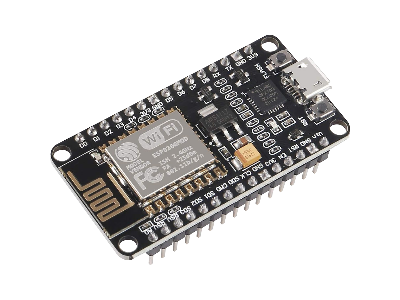
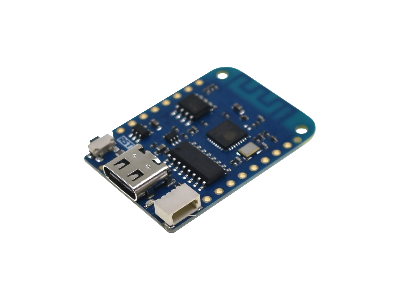

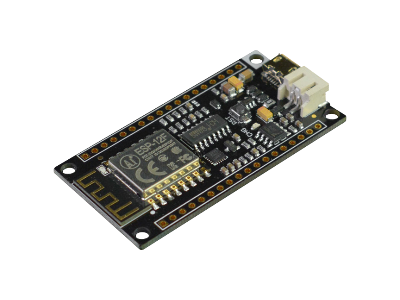
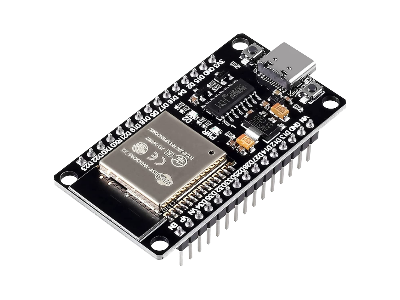
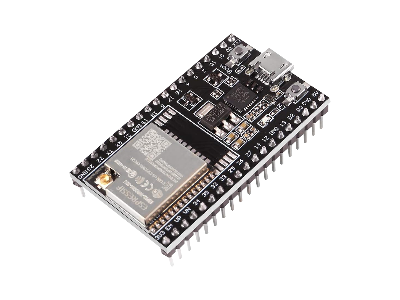
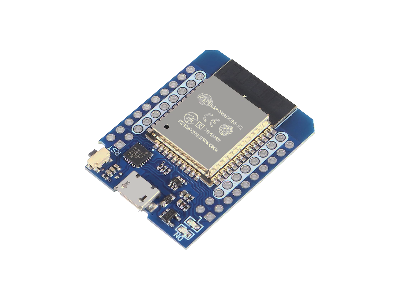
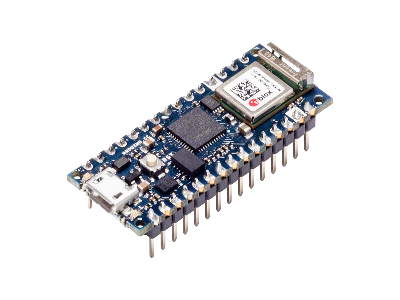
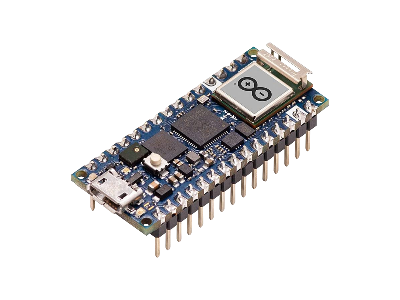
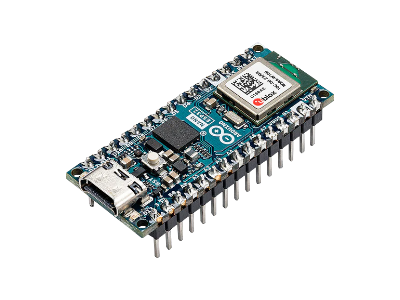
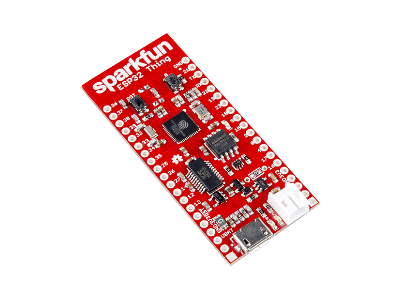
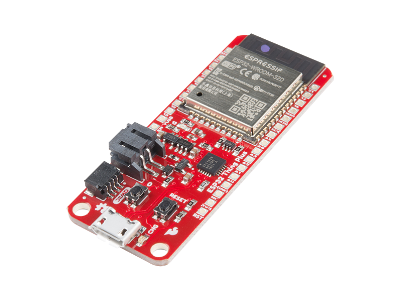
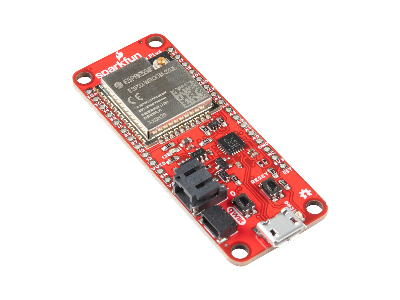
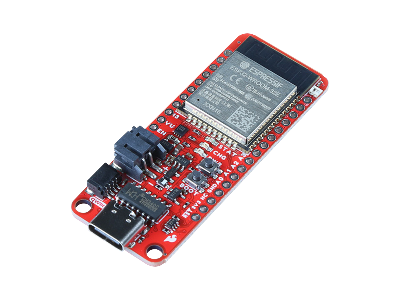
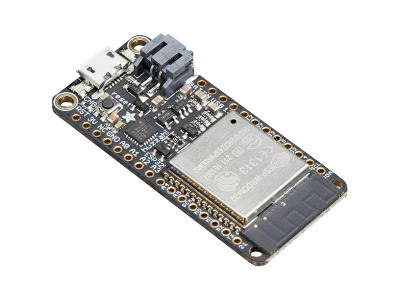
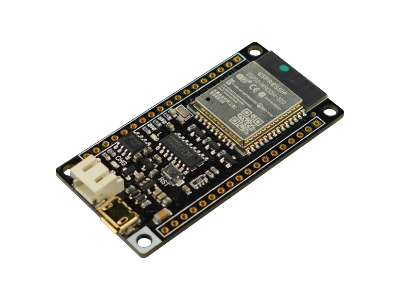
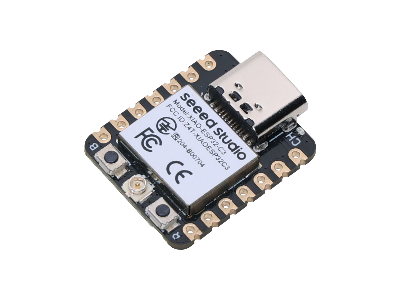
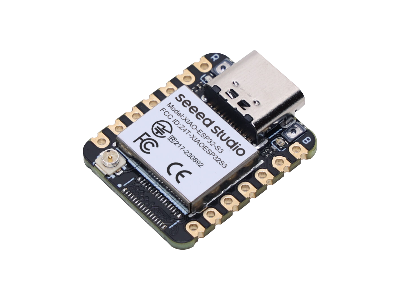

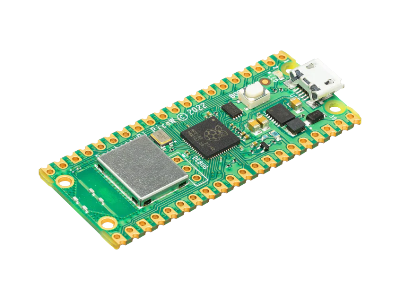

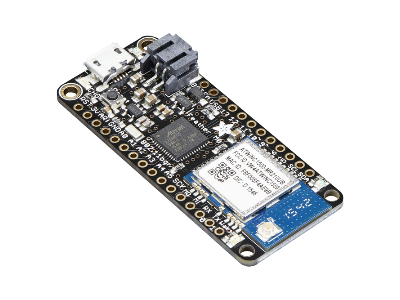

(0) Comments
Sign in to leave a comment
Sign In